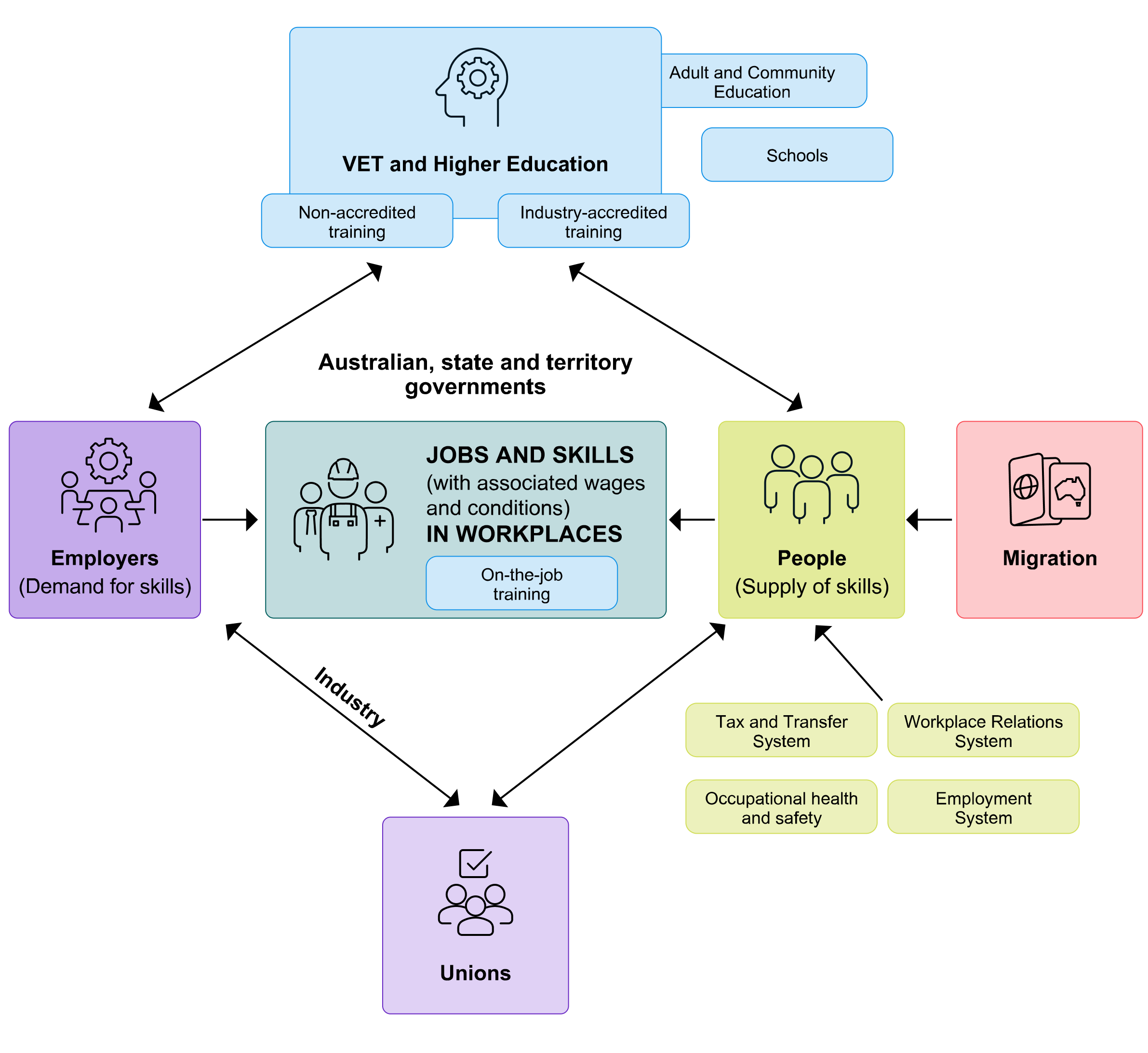On this page
The role of Jobs and Skills Australia
Australia faces a skills challenge not seen since the 1960s. In response to this challenge, Jobs and Skills Australia was established in November 2022 under interim legislation, superseded by permanent legislation in August 2023. Its mission is to be a catalyst in activating the potential of Australia’s human capital to meet the present and future skills needs.
Jobs and Skills Australia’s central role is to advise government and key partners in the national skills system on Australia’s skills needs and the adequacy of the skills system in meeting those needs. It has been supported by a tripartite Consultative Forum, to be replaced by a tripartite advisory board under the permanent legislation and works closely with the 10 Jobs and Skills Councils, and with the states and territories.
Strategic objectives across the labour market and the economy
In 2023, Australia is experiencing a tight labour market and extensive skill shortages, as well as significant price inflation and continuing low productivity growth. Despite this tightness, the labour market has been slow to lift wages growth, which have been stagnant for a decade.
As the Reserve Bank of Australia (RBA) focuses on bringing inflation into the 2 to 3% target range, a focus on matching workforce skills with industry’s needs is required to enable the economy to minimise the level of unemployment and underemployment that can be achieved alongside stable inflation.
A focus on enhancing Australians’ skills also aims to support increased productivity, real wage growth, increased labour force participation and sustainable economic growth.
A focus on enhancing opportunities for those who are disadvantaged in the labour market aims to support more equitable outcomes in employment opportunities and rewards.
These are the high-level objectives that Jobs and Skills Australia is seeking to support: minimising unemployment and underemployment; increasing productivity, real wages, participation and sustainable economic growth; and increasing equity and reducing disadvantage. Supporting these objectives will involve anticipating how jobs and skills need to evolve to help the national skills system deliver the skills people will need for the objectives to be achieved.
The Australian Government’s recently released Employment White Paper, Working Future, outlines 5 objectives in its vision for the future of the Australian labour market, which we see as highly congruent with the 3 objectives outlined above.
Towards a national jobs and skills roadmap and a joined-up national skills system
Three key pillars of the national skills system are: vocational education and training (VET), higher education, and migration (Figure 1). Jobs and Skills Australia focuses primarily on these 3 key pillars and how they work within the broader jobs and skills ecosystem which includes, for example, the school system, informal on-the-job training, unaccredited and industry-based training, and system settings, like employment services and wage setting and workplace relations frameworks, and especially the way that wages adjust in the labour market.
Figure 1: The national skills system: conceptual view (illustrative)

Source: Jobs and Skills Australia
To meet the current skills challenge and the skills needs of the future, Australia will need a systematic approach to building foundation skills for all those entering the workforce, through to the extensive knowledge and workforce skills that are required at the highest level. This will require our education, training, and migration systems to effectively complement each other and flexibly respond to skills and workforce needs. And we will need the whole population to be supported by a lifelong learning system that enables them to continually develop their skills to meet the needs of a dynamic economy and changing labour market.
An interconnected systems view of the national skills system to better address current and future skills challenges is recognised by stakeholders as beneficial, while also acknowledging that industry, jurisdictional and pillar-specific nuances will continue to be important.
In 2023, a number of important reform processes of systemic importance to the national skill system have been progressed, with negotiations towards a new National Skills Agreement, a review of higher education leading towards a new Universities Accord, and the Australian Government’s Migration Strategy which will also lead to significant reforms. These reform processes have identified the importance of synergy between each of these pillars of the national skills system, and a role for Jobs and Skills Australia in supporting the implementation and monitoring of policies in a way that seeks to ensure that they complement each other.
As these reform processes are charted out, Jobs and Skills Australia will develop a national jobs and skills roadmap in partnership with Jobs and Skills Councils, states and territories, business and unions, the education and training sector, and Australian Government agencies. Such a roadmap starts with an analysis of jobs and skills pressures and drivers, which is a key feature of this 2023 report. It would then map out the reforms required to deal with these pressures and drivers. Then comes the policy implementation stage. Finally, the implementation of policies will need to be monitored against the objectives they are seeking to achieve, with the feedback leading to further refinement of the strategies adopted.

